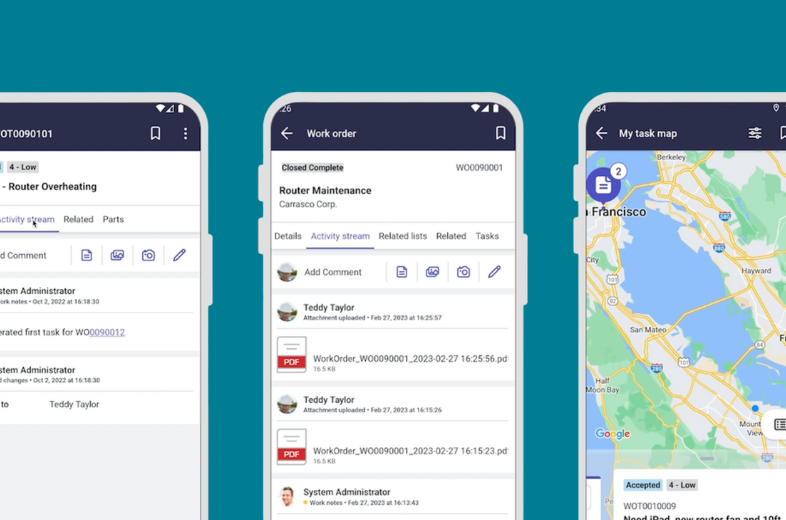Connected Field Service Webinar: Explaining the What, Why & How

Published Date
The philosophical question, “If a tree falls in a forest and no one is around to hear it, does it make a sound?” has more to do with connected service than you’d think.
In fact, in our industry, we ask a similar question and that is, “What’s the point of collecting incredible data from the field if you don’t share it across your systems?”
While both questions are meant to make you think, the latter comes with a definitive answer – connected service.
A connected service conversation with Bolt Data and ProntoForms
Because connected service is a subject that's gaining popularity, our CEO Rob Meredith recently partnered with Mansell Nelson, Senior Vice President of Business Development at ProntoForms to present an informative webinar on the topic.
What’s happening in the field service industry?
Recently, there’s been a shift in focus to creating and analyzing in order to obtain more data about buying patterns, customer behaviors, asset performance, utilization, and more.
To that point, Gartner reports that 90% of executives feel the Internet of Things (IoT) will enable them to substantially improve how they deliver products and services for the next two years.
Conversely, on the manufacturing side, 50% of all industrial assets manufactured today are IoT-ready.
With this in mind, it’s important to realize these aren't just trends, they’re the future.
Businesses that take time to put themselves in the position to handle this shift will reap the rewards.
What is connected service?
We're seeing a recurring theme in our industry where companies are investing large sums of money into automation but they aren’t doing anything with the findings.
Yes, they’re aware an asset might fail in a number of days, but that information isn’t delivered directly to the service people who can proactively handle the situation.
This is where the value of connected service comes to light by connecting smart assets to the business system not just to the enterprise data lake.
The additional benefits of connected service include:
- Administer assets, IoT rules, and AI algorithms
- Monitor and visualize asset performance
- Analyze trends and detect operating anomalies
- Prescribe and automate service activities
- Empower call center agents and field technicians
Why does connected service matter?
A monitored machine works better than an unmonitored machine.
Although obvious, it’s true. That’s because when it comes to connected service, the idea of less is more is at play.
But, it might not be why you think.
Let’s take a look.
Companies that adopt connected service in order to improve their asset dependability see a 75% reduction in asset failures.
Now, depending on how critical the machine is, that alone could be saving companies a significant amount of money.
And, when the other 25% of assets actually do fail, the downtime is reduced by 45% on average.
Companies that leverage connected service see a 30% reduction in service costs.
For instance, because of automation, companies can reduce some of the back office service operations tasks or even avoid truck rolls because the company could see the asset was working when the customer called and resolved it over the phone instead.
Finally, people who adopt connected service see a 50% reduction in customer complaints.
Now, do you see how connected service embodies the less is more mantra?
Thanks to the reductions in asset failures, downtime, and customer complaints, companies that utilize connect service get more out of their machines and data to better serve their customers.
It doesn’t stop there. Companies that leverage connected service also see improvements in:
- Asset dependability - Monitoring real-time asset performance and operating trends empower service teams to keep assets running by detecting anomalies, predicting failures, and responding proactively.
- Service ease and profitability - Real-time asset data enables service teams to improve operating efficiency, reduce service delivery costs, create new revenue streams, and generate scalable growth.
- Customer experience - Improved asset uptime and service response times, plus enhanced call center support provide a modern service experience that improves customer satisfaction and retention.
How does connected service work?
Connected service is more than just getting an asset talking to your enterprise data cloud with some basic analytics and reporting behind it.
Though it’s important to know ahead of time that an asset is going to fail, that information alone isn’t as valuable as it is when it’s paired with actionable solutions.
Connected service bridges the gap between business systems and service systems.
When we can extend IoT data to the business application and put that information into the hands of the professionals who need to do something with it, that’s where the real value comes to light.
Think of it like the last mile which seamlessly brings the problem over the finish line to the solution.
IoT and connected service
When you know what’s going on with your assets you can make better decisions.
That’s the promise of IoT.
But, that promise is only kept if you have an intuitive dashboard and analytics at your fingertips that are fully integrated in your business systems. When you have those pieces of the puzzle in place, decisions become a lot easier and happen faster.
The ability to put IoT into the hands of technicians is like putting a patient’s vitals into the hands of a doctor.
Without concise and accurate patient data, physicians would struggle to help the patient.
In this case, when a technician knows what they’re up against before they leave the shop and they have the right knowledge articles to do their job, they have a much higher probability of servicing faster and doing it right the first time.
When you know what’s going on with your assets you can make better decisions.
Contact us today to learn more about how we can help your organization with connected service on Salesforce.




